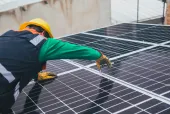Expensive solar costs impede larger deployment
By Agostinho Miguel GarciaThe cost of solar usually comes as the barrier for a larger solar deployment. Fit and PPA driven by RPS have lead the path for the revolution in Renewable Energies leading wind to achieve more than 100 GW and PV more than 20 GW.
Asian countries claim that cannot pay the extra cost and prices have to come down. Prices did have come down and wind fell to half of its price while PV has witnessed a remarkable descend going down more than 5 times! So where is grid parity and where is the LCOE of these renewable technologies?
There are plenty of islands running on diesel in Asia where the KWh generated is already more expensive than the solar electricity unit.
One of these cases is the Maldives. These islands situated in the middle of the Indian ocean draw thousands of high end tourists every year and the cost in all islands is more than 0,20 USD and in some it goes to 0,30 USD and in the islands furthest away may reach 0,60 USD and 0,70 USD.
Solar costs are currently below 2 USD per installed watt and with the solar radiation of the Maldives the LCOE is below 10 cents. Coupled with that, solar energy will not become more expensive and there will be no supply crunches! So what is stopping solar to penetrate in the Maldives? And in the other Asian islands? The Philipines? Indonesia?
The reason seems to lie on technical questions, political will, fear to be the first mover, lack of local technical expertise, conventional fuels lobby and still: it is expensive!
Asian power includes little solar generated electricity and even the easiest, the low hanging fruits are not hanging that low! All Asian solar manufacturers have their eyes cast on Europe and the US while the biggest market lies next door: Asia.
Solar revolution may support Asian countries achieve a energy cost buffer, autonomy and even ability to increase its electrification ratios by channelling local production, benefiting from the low cost of Chinese and Korean manufacturers still with the more famed Japanese brands.
The Maldives alone register around 150 MW of power if we count public and private sectors (resorts) that are yet to be tapped. Maybe Asia as the new world power house still needs to welcome solar and green technologies in its homeland instead of looking only to export them!














 Advertise
Advertise











